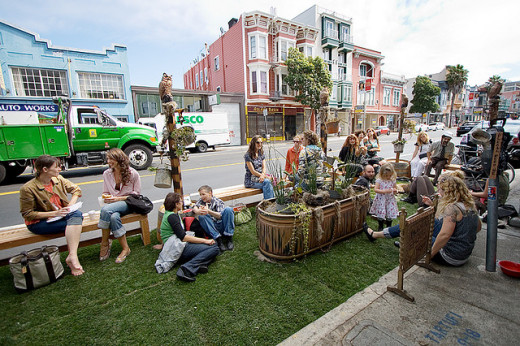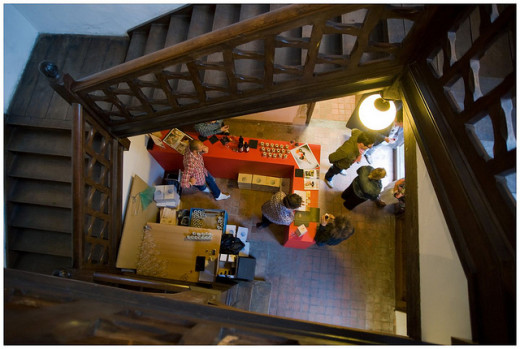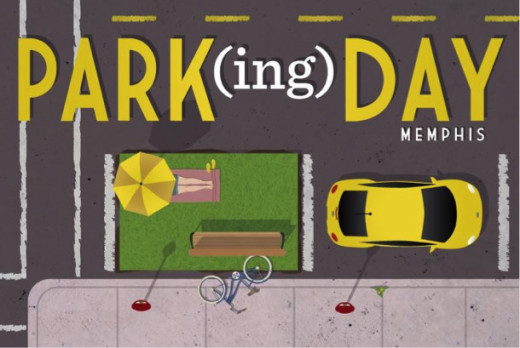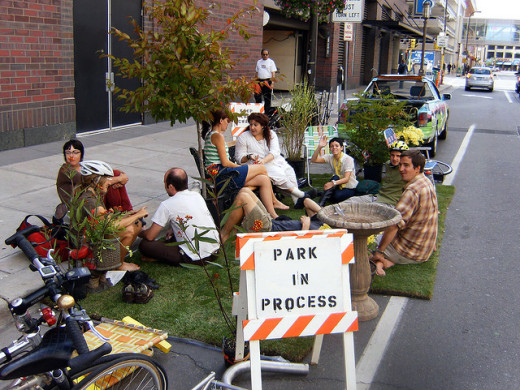
“Tactical Urbanism” is one of the latest widely-used buzz words in the community building industry. It generates excitement and enthusiasm from activists, but concern and disdain from some municipal officials. Can some tactical urbanism take on the form of selfish vandalism or can it reflect a powerful form of community-supportive activism?
To explore these polar views, we need to discuss what exactly is meant by tactical urbanism, and get a sense of its possible range of activities, such as:
- A new temporary use for a vacant lot, such as a pop-up dog park or bocce ball court.
- A one day reuse of metered parking spaces for a mini-park, outdoor seating, or sidewalk café.
- Construction and placement of outdoor seating in public spaces that lack places to sit.
- Conversion of underutilized roadway pavement to public plazas or bike lanes.
- Occupation of temporary pop-up retail shops in previously vacant storefronts.

The concept of tactical urbanism has been around for several years under the terms “guerrilla urbanism,” “city repair,” or “do-it-yourself “DIY” Urbanism.
The concept of tactical urbanism has been around for several years under the terms “guerrilla urbanism,” “city repair,” or “do-it-yourself “DIY” Urbanism.” In fact, you may have read about city repair in a post this past summer by PlannersWeb Editor Wayne Senville, “Can Intersections Lead to Stronger Neighborhoods & Empowered Residents?”

The results are typically a series of small-scale interventions that alter the public realm, making it (at least to its advocates) more user-friendly for the public.
In the Street Plan Collaborative’s, Tactical Urbanism, vol. 1 1 Mike Lydon describes tactical urbanism as having the following characteristics:
- A deliberate, phased approach to instigating change;
- The offering of local solutions for local planning challenges;
- Short-term commitment and realistic expectations;
- Low-risks, with a possibly a high reward; and
- The development of social capital between citizens and the building of organizational capacity between public-private institutions, non-profits, and their constituents.
Lydon refers to the interventions or tactics as “short-term actions that were demonstratively leading to long-term change.” Examples best used to describe these interventions include: PARK[ing] day, chair-bombing, pavement to plazas, guerilla gardening, and pop-up shops.
PARK(ing) Day is an initiative where citizens and activists collaborate to creatively transform metered parking spaces into temporary public places. The concept was originally conceived in 2005 when a San Francisco firm, Rebar, converted a single metered parking space into a temporary public park in an area that was underserved by public open space (see video below).

According to PARK(ing) Day’s web page: “the mission of PARK(ing) Day is to call attention to the need for more urban open space, to generate critical debate around how public space is created and allocated, and to improve the quality of urban human habitat … at least until the meter runs out!” 2
Rebar decided to promote the initiative as an “open-source” project by creating a how-to manual to empower people to create their own parks. PARK(ing) Day has since grown into an international event in hundreds of cities on the third Friday of each September.

Chair-bombing is another tactic that creates and installs seating in a public space where places to sit are desirable but lacking. This rather simple gesture goes beyond offering a seat to others, it has been used to recycle disposed materials, generate social activity, as well as define key locations where additional public improvements should be made by municipal officials.

This tactic was first generated by a Brooklyn collective called DoTank that carried out urban interventions from 2009 to 2011. Their website describes “chair-bombing as the act of building chairs out of found materials, and placing those chairs in a public space in order to improve its comfort, social activity, and sense of place.” 3
As DoTank’s website notes, “[its] chair-bombing process began by building Adirondack chairs made from discarded shipping pallets. The DIY chairs were placed in public areas that were in need of street furniture.”
DoTank boasts that chair-bombing has been replicated beyond New York to cities such as Philadelphia, Dallas, and Memphis.
Pavement to Plazas conversions “reclaim” oversized streets that are underutilized and lacking in public space. Lydon explains that these interventions typically start by using temporary, inexpensive materials to re-assign excessive vehicle space on key streets for use by pedestrians or bicyclists.
“By taking this experimental, ’lighter, quicker, cheaper,’ approach, the City and public-at-large are able to test the performance of each new plaza without using up scarce public resources. If successful, the intervention can then transition into a more permanent design and construction phase.” 4

Interestingly, most examples of pavement to plazas initiatives have been led by city officials and departments, however sometimes a groundswell of neighborhood activists take the lead. This was the case in the Broad Avenue neighborhood in Memphis, Tennessee.
City officials, after some hesitation, cooperated with neighborhood tacticians by putting a “New Face on Old Broad” 5 in Memphis’ Binghamton neighborhood. This community-led initiative redesigned Broad Avenue and painted new bike lanes, crosswalks, and head-in parking spaces. The new installation was tested and launched in a public neighborhood celebration.
Some publically endorsed entities, such as the Memphis’ Mayor’s Innovation Delivery Team (MIDT), 6 have facilitated tactical urbanism as a key component of their economic development strategy. MIDT leaders advocate the need for targeted small-scale urban interventions because:
- Neighborhoods and cities are complex, there are no silver “redevelopment” bullets.
- Government is not oriented to deliver neighborhood level solutions.
- Many, small scale projects can aggregate to big, sustainable change
- Creative placemaking is a key component of economic development.
Focus in the new economy has to be:
- Low-risk projects that have the potential for high-return.
- Prototyping ideas to gauge neighborhood readiness for capital investment.
The excitement from a “New Face on Old Broad,” led to the attraction of 25 new businesses reclaiming 17 previously blighted properties — and six public art installations. As for the temporary street redesign, it later was approved and adopted by the city’s traffic engineering and remains intact today.
“Illegal, Potentially Unsafe, and Vandalism”
In some communities, municipal officials have gone on record (at least initially) as staunch opponents to tactical urbanism. For example, a series of tactical urbanist interventions in Hamilton, Ontario raised strong objections by city officials, pitting the public works director against local activists.
Spacing Magazine, which covers the urban landscape in Canada’s major cities, reported the government crackdown on some of the tactics: “The campaign drew an aggressive response from the City’s general manager of Public Works, Gerry Davis, who reported the incidents to the police and issued a memo to Council calling the actions ‘illegal, potentially unsafe,’ and ’vandalism.’ City workers removed the installations.” 7
The magazine pointed out that Davis’ city memo left unmentioned “the ongoing danger and liability from Hamilton’s status quo of pedestrian- and cyclist-unfriendly automobile oriented streets, a legacy that has persisted for decades despite an official policy to promote walkable streets.”
After the dust settled from the conflict, the City of Hamilton altered its position and released a report proposing a partnership with the activists and offering funding to help with future urban interventions. The report, “Tactical Urbanism Hamilton Partnership,” 8 documents Hamilton’s position on tactical urbanism:
“While there are safety and liability concerns associated with these types of unofficial activities, many of the broader objectives of Tactical Urbanism are shared by the City of Hamilton. In order to further develop this partnership, this report recommends providing a seed funding contribution for Tactical Urbanism Hamilton to develop an outreach, engagement and communication strategy that will allow broader public participation in identifying potential projects.”
Tactical urbanism highlights the tricky tension that exists between the role of public officials and community activists interested in improving the public realm.
Tactical urbanism highlights the tricky tension that exists between the role of public officials and community activists interested in improving the public realm. Stories of continued success of urban interventions, combined with a lack of actions on public improvements by city officials, will encourage more guerrilla urbanists take these matters into their own hands.
Will tactical urbanism evolve as a productive, collective movement or will rogue interventions prove to be a series of self-interested exploits? This brand of activism refuses to be ignored. It provides a role for citizens in community revitalization, which has the potential to change our cities for the better. Better communication between municipal officials and community activists can forge new public-private partnerships to leverage this movement to the benefit of our communities.
Andy Kitsinger is a principal consultant at The Development Studio, a firm focused on helping clients build stronger communities. He writes about Downtown and Main Street Issues.
Kitsinger’s thirty-year career as an architect, urban designer, city planner, and teacher has focused on creating authentic places that are strongly influenced by their context and have a positive impact on their community. He teaches Issues in City Building and Architectural Design Studio at the University of Memphis’ Department of Architecture.
Kitsinger served as the Senior Vice President of Planning & Development for the Downtown Memphis Commission (formally Center City Commission) for the last eight plus years where he helped continue the momentum of downtown while working to improve the livability and the quality of life in the City.
Editor’s note: Interested in learning more about tactical urbanism? Take a look at this short (11 minute) video of a talk by Mike Lydon at the Congress of New Urbanism national conference in Salt Lake City in March 2013.
Notes:
- Tactical Urbanism, vol. 1 ↩
- PARK(ing) Day web site. ↩
- Do Tank website. Along similar lines, Tactical Urbanism, vol. 1 describes chair-bombing “as the act of removing salvageable material from the local waste stream, and using it to build public seating. Chairs are placed strategically in areas that are either void of social activity, or conversely, those that are rich with life, but lack comfortable places to sit.” ↩
- Tactical Urbanism, vol. 1. ↩
- Broad Avenue Arts District ↩
- Memphis’ Mayor’s Innovation Delivery Team. ↩
- “Report from Hamilton, Ontario: Tactical Urbanism crackdown,” Spacing Magazine (May 10, 2013). ↩
- City of Hamilton, City Manager’s report on Tactical Urbanism (pdf). ↩